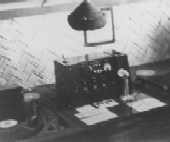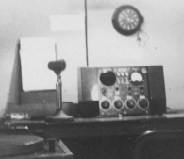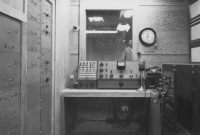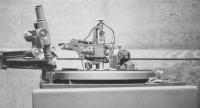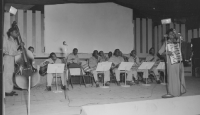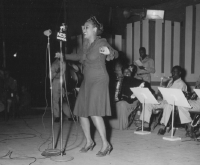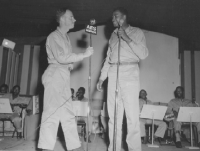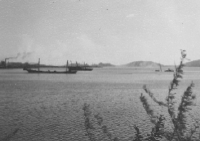A
SHARPE REPORT
By Ivan Saddler
Copyright 10/2001 SMECC
Before
reviewing the book Star Spangled Radio by Kirby and Harris, I want to
establish my credentials. The
two aspects are 'Electronics in my Genes' and 'Military Experience'. By hindsight, I want to add a third section to this part of
this saga. It will deal with
the part of the South Pacific war
not usually told in books of history. It
will deal with the personal side of war.
Electronics In
My Genes.
I donít
really know whether there is such a thing as genetic propensity to
electronics. My father was
always employed in electrics and electronics.
The earliest work I know of for
him was the installation of AC to DC rotary converters in theaters for
operation of the arc lamps used in early movie projectors.
He later owned a radio repair shop in Calexico CA.
He also built one of the earliest metal detectors to search for gold.
Imagine lugging around a tube operated detector with itís three dry
batteries.
I had built a
crystal radio when I was eight using the proverbial Quaker Oats box as a
coil form. Still using a
crystal, a variometer was the next more sophisticated tuning device.
That was bought with profits from selling Liberty magazines in
downtown Dallas. The first
major construction project came while in high school.
In 1934 I had gathered enough parts to build a tube radio.
The coils were wound on four-prong tube bases.
The major problem was a rectifier within my budget-basically zero.
My lifetime mentor was Gray Moore, the chemistry teacher at Forest
Avenue High School in Dallas TX.. He
and I built a system of rectifiers consisting of prescription bottles
containing dilute boric acid and two dissimilar metals.
I believe they were copper and silver wires.
The tube was one of the first cap grid vacuum tubes. It was a 22A. Remember this was 1934.
It was a banner day (night, really) when I picked up WGN broadcasting
on short wave, test television pictures.
The announcer would say the next picture will be of Felix the Cat.
All I would hear was a series of buzzes.
This was early black and white sequential TV.
Soon that was topped by reception of broadcasts from Madrid, Spain.
I was hooked.
Getting married
and making a living shoved electronics into the background for a time.
On Sunday December 7th 1941, I had been working to catch
up. While driving home I heard
the news of the attack on Pearl Harbor. All of my friends and I knew major
changes were in store.
I had yearned
for further education in electronics but college was too costly and time
consuming. I chose to attend
evening school at Dallas Technical High School.
The electronics course was taught by a man named Durward Tucker.
He was the chief engineer of the Dallas Municipal Radio Department.
That organization installed and maintained the radios in police cars,
then receiving on approximately 1700 KHz and transmitting at 30 MHZ. The police base station transmitter was a Western Electric
10KW unit which had been retired from broadcast service and converted to the
slightly higher frequency. The
other service was a commercial broadcast station, WRR. The studios were located at the State Fair Grounds while the
transmitter was located on a hill outside of Dallas and overlooking White
Rock Lake. Mr. Tucker decided I
would make a good technician and invited me to work for him.
At that time
anyone who touched a transmitter was required to have a license from the
FCC. After some cramming I did
pass the test and obtained a First Class Radio Telephone Operators License.
All of the radio equipment was the responsibility of the small crew
of technicians. Soon I was also working at the control console for the radio
station to fill in on Sunday mornings.
After a year or
so, the war was becoming more intense and the services were needing more
radio/electronics types. To
relieve the shortage, the government instituted a training program called
Engineering Science Management War Training (ESMWT).
Six months training in San Antonio was followed by Pre-Radar School
at Southern Methodist University. That
was fun, getting paid to be trained. We
were supposed go to Florida for Radar training next. Somehow, the wheels fell off and I found myself in boot camp
at Mineral Wells, Texas for a short time.
Then came basic training at Camp Koehler near Sacramento, Calif.
It no longer exists, having burned before the war was over.
Next came Specialists School at what was then called Cal Aggie, now
UC Davis. Most of my school
mates ended up in repair stations on Oahu.
Not for me.
A bulletin was
posted one day which announced that an organization was being formed and
named Armed Forces Radio Service. There
was a requirement for people with broadcast experience. After a hastily filled out application, I soon found myself
train-bound for Hollywood. That
assignment seemed more to my liking than trouble shooting equipment at Oahu.
And by hindsight, it was an unusual experience.
At that time
AFRS was just forming. It and
the First Motion Picture Unit under Frank Capra and AFRS were co-located on
the 20th Century Fox Studio movie lot at Sunset Blvd. and Western
Ave. in Hollywood. That was a
most unlikely military base. Most
of the enlisted men who would form the Pacific crews were housed at the St.
Francis Hotel on Hollywood Blvd.. Rudy
Rubin from Midland, Texas and I shared a room there.
Col. Tom Lewis, True Boardman, Billy Bardy and a few others were
there occupying offices. Our
First Sgt. was Bob LeMond. The
only other enlisted man was Paul Masterson.
Both has been announcers in the Los Angeles area.
As the crews began to form, we knew from rumors that one group was
headed for CBI, another to Espiritu Santos, one to Guadalcanal and
headquarters would be at a station in New Caledonia.
Of course many others followed.
The major delay was gathering a full complement of equipment and gear
with spare parts before we left for wherever. That wait was both good and
bad.
While most of
the time we sat around playing poker, we were supposed to be training.
For what? We were
already pros at what we were supposed to do.
Instead, we watched movies being made,
went through military vehicle driving school at Santa Anita Race
Track, and survived Survival School. It
was a real shock to crawl along through a live mine field, with pigs guts
all around and live machine gun fire not more than six inches above your
butt. The last indignity of the
day was having to go into chambers with war gases and to take off the gas
mask just before leaving.
Brass Button
Broadcasters details most of the innovations made by AFRS.
The use of vinyl for transcriptions was one.
C.P. McGregor did much of the production with Radio Recorders doing
the rest. I remember a fellow named Eddie Della Pina who made
everything work there.
But there were
some fun times, too. We as a
crew went to a place in the desert near Barstow and
The other fun
time wasnít long in coming. The
equipment had been assembled and it was time to go.
We decided to have a farewell party for our crew at Brittinghams, a
then famous restaurant close to the CBS studios on Sunset Blvd.
To the surprise of most of us, Bob Hope, Bing Crosby and Jerry
Colonna joined us and entertained with a few gags.
Tell me about real people.
To Angel Island
for shots, tropical uniforms and boarding of a solo merchant marine
zig-zagging trip to, ultimately, Guadalcanal.
There wasnít anything there. We
built our transmitter house, our quarters and most of our studios.
And yes we installed our equipment.
Our transmitter was an RCA 1 kilowatt unit. And like Trent Christman,
I climbed the palm trees to erect our receiving antennas.
I was elected because it somehow leaked that I had been to Signal
school and knew how to use climbers and a belt.
The first time was exciting. I
was about half way up the tree when I put my hand on a wasp nest.
If I hadnít had on the safety belt, the story might have had a
different ending. From then on
I took some newspaper and a cigarette lighter on such trips for burning off
wasp wings.
My military
occupational specialty (MOS) said I was a radioman, first class.
Things worked well after a time.
The GIs began to complain that there was little or no western/ hill
billy music on our Mosquito Network Station.
You know the result, Ivan became Texas Jack.
You also know that after Polly and I were married we moved to El Paso
to attend what was then Texas Western College, now UTEP.
We paid our way through college by being disk jockeys on a program
called the Jack and Polly show. Yes,
it was hillbilly/western, patter and mail-in requests.
Many of the
stories worth telling are in Brass Button Broadcasters. After some time, life became routine. I applied for Officers Candidate School as did Rudy Rubin and
George Dvorak. Rudy and I also
applied for direct commissions. Signal
Officers were needed in the Philippines.
I donít know how it happened so fast but in a few days we both were
lieutenants. Rudy used to kid
me about outranking me. We were
sworn in alphabetically (the Army way).
Yes, he outranked me by five minutes.
George Dvorak chose OCS and was shipped to Ft. Monmouth.
The war was over shortly thereafter.
He played solitaire until he was discharged.
Several folk who were later well known came through the Guadalcanal
station. One I recall was Jack
Kruschen. After the war he was
well known as an actor. He and
a writer named Norman Korwin joined forces for many successful shows.
Another later well known was Eddie King.
Others passed through but after 50 years, their names fade into the
past. Dick Sinclair with whom I
spoke recently and I are the last two of our crew.
He is only 76 so his memory is better.
|
AFRS Espiritu Santo |
|
|
|
|
|
|
|
|
|
|
|
|
|
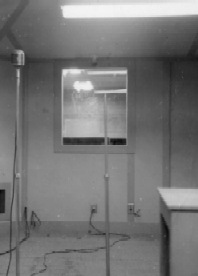 |
|
|
AFRS and USO Scenes in New Caledonia
Printed Caption on the back of the photo reads:: Ann Lewis Member of a colored USO Troupe is
shown during a performance on stage of the 130th qm BN theater (US A.
SC Photograph 16 May 44) Capt Joe Thompson, manager of AES
Radio Station, left, and Kenneth Spanner, are shown on the stage of
the 130th QM Bn theater during a broadcast of a colored USO
Troupe. (US A. SC Photograph 16 May 44) Harbor, Noumea New Caledonia |
|
After the war
was over, it was still necessary to entertain the troops. As things were winding down, I was transferred to New
Caledonia as were most of the Guadalcanal group.
There we were joined by Jack Parr, Jackie Cooper and Jack Carter.
Another couple of guys whom you might have heard were also there, Ed
Reimers (youíre in good hands with Allstate) and Bruce Collier.
After the war Bruce was with WGN in Chicago as was Spencer Allen.
More about Bruce later.
My return to
civilian life was much less exciting but just as satisfying.
It didnít last long, though. A
short time with an electronics company in Dallas and time out to get married
to Polly (53 years ago) were a hiatus.
The fellow who was last in charge of AFRS in the Pacific after
cessation of fighting with the Japanese was Capt. Clifford Frink who
remained with AFRS as an officer for some years..
One function of AFRS after the war was known as the Bedside Network.
BBB mentions this on p. 60. The unit was headed by then Major Frink.
That organization was to provide wired systems in military hospitals
and to perform just like the out-of-the-country broadcast AFRS.
Major Frink leaned on me and asked me to set up the system for
William Beaumont General Hospital in El Paso.
Itís specialty was burns and reconstructive plastic surgery.
That was much more fun than installing and operating the sound system
at the Texas State Fairgrounds.
The system at
Beaumont was, with lots of competent local help, soon up and running.
El Paso had long supported two AM radio stations.
An upstart group, Griffith Broadcasting, planned to compete in that
growing market with a 10 KW four tower phased array designed to protect a
station in the same frequency (700KHz) in Independence, KS. The call letters
were KEPO (now KHEY). I decided
to help build and operate the station under a really good chief engineer E.
Louis (Louie) Gemoets. And
later came the Jack and Polly Show mentioned elsewhere along with college at
UTEP.
Military
Experience
Just as
electronics was inbred, so was the military.
My father was in the Cavalry and my step-father was in the infantry
during World War I. While I was
in high school I was in Junior ROTC as were most of the studs.
At the same time several of my friends and I joined an Army National
Guard Unit while it was being formed. It
was A Battery, 133rd Field Artillery, 36th Division,
Texas National Guard. Yes we
were called Saturday night soldiers, but it was fun. In the summer we would pack up and go to Camp near Palacious
TX. Our guns were 155
Millimeter howitzers. Man, you
have no idea of the sound volume when those babies were given the maximum
charge. My job was aiming the
guns so I was always behind them and near.
It was possible, from that position, to see the shell travel.
I have already
in the previous section mentioned my military experience during World War
II. When being ordered off
active duty, it was normal to sign up for inactive reserve-mistake. The Korean conflict came along just as I was completing my
degree work. I was called back
to active duty with my last final and physical for return to active duty
coming the same day. The
Pentagon was home for that war but my job was heading a crew of young guys
with degrees and little experience install radio stations all over the
world. These were
point-to-point stations for communications, not entertainment.
I did whenever possible visit local AFRTS stations.
The world had changed a lot.
Personal
Stories (In no particular order)
The rain at
Guadalcanal was legendary. I
seem to recall the total was about 100 inches per year. That amount called for deep ditches for runoff.
Between our studio and quarters there was just such a moat.
It was spanned by a rough cut plank about ten inches wide with enough
thickness to support several persons. Blackout
conditions were still in effect because of the possibility of air raids or
naval attacks. One evening
after we shut down the station, Dick Sinclair, Hy Averback and I were making
our way to the quarters. It was
a moonless night. As we were
crossing the ditch, Hy Averbach slipped and fell into the ditch.
With much cursing and pulling we managed to get Hy out of the ditch.
Once inside the quarters, we could turn on the light.
What we saw was the original of the creature from the black lagoon.
With black mud and green slime all over him, it was impossible to
keep from laughing. To Hy it
wasnít funny. I believe at
that moment he decided that war was hell and he wanted no more of it.
He soon was in New Caledonia, a much more civilized place.
You may recall much later he was the producer of M.A.S.H.
Iíd bet some of the sequences of that program still in syndication
came from such experiences.
As the war
island-hopped north, Guadalcanal became a supply base and a place for TDR&R
(Temporary Duty for Relaxation and Recuperation) for troops.
Even those of us stationed there found time to relax.
Special Services often thought up fun things to do.
One day, several of us deicded to go salt-water fishing for tuna.
We trolled back and forth in the harbor between Guadalcanal and
Tulagi, among ships be loaded with supplies for the war effort north of us.
It didnít even occur to us to be wary of an ammunition ship being
loaded as we passed. We caught
several nice fish. Even at that
time, blackout conditions prevailed. We
often fretted about the inconvenience.
That night was one bright moonlit night.
The station was off the air for the night, and we had eaten the fish. Dick Sinclair, George Dvorak and I were going to our
quarters. We stopped to urinate
in a ditch before turning in for the night.
We were speculating about whether Guadalcanal would become a tourist
destination after the war. The
palm trees were romantic and we could visualize wide paved highways for
cruising with the top down. About
that time we saw a huge column of flame shoot into the air with a lazy smoke
ring around it. The harbor was
about a mile away. That
was where the flames originated. We
could see the palm trees bending in our direction and knew that blast was
headed our way. We all jumped
into the ditch without a thought of the urine.
the blast destroyed our quarters but it was the shrapnel that we knew
was more dangerous. It sounded
like doves flying near. We
didnít know it at the time but it was reported that a Japanese submarine
had sent a torpedo into that just loaded ammunition ship named the Surpens.
There was only one survivor, who had been blown out of an open hatch.
Two hundred and sixty were not so lucky.
Rudy Rubin and
I became officers at the same time and were room mates in the batchelor
officers quarters. We soon
discovered that officers could get what were known as rations.
Not the usual kind but booz. The
theory was that we could order a specific dollar amount of whiskey each
month and the orders would be loaded as cargo in the next available ship
from San Francisco. That was
neat. As enlisted men we had
only beer or jungle juice. The
latter was brewed up by enlisted men in the Quartermaster Corps.
They could liberate fermentable things, usually raisins, which would
be fermented, distilled and sold. Rubin
and I could order a maximum of two rations of whiskey per month.
That was adequate, if not too much.
The problem was that for several months no supplies arrived.
Officers were leaving often and would sell their expected rations for
pennies on the dollar to recover any thing.
Fortunately or unfortunately all those supplies came in at once. We had so much booz that we stored it under our beds and any
place else which was secure. Word
was out that we owned the whole supply of whiskey on the island.
Before I left, I owned a command car, a sub machine gun, and almost
anything else which didnít have a permanent home.
I soon left for New Caledonia. Rubin
inherited the whiskey stash. He
ate high on the hog until he had to leave.
I have often wondered what happened to that stock.
Rudy Rubin isnít around anymore but he was a west Texas horse
trader. I imagine he left
Guadalcanal with stuffed pockets.
New Caledonia
was never in any danger of Japanese invasion.
It was too far away. The
islands had been owned by France for many years and had developed a
colonial, genteel way of life. The island was of strategic importance to
France. It had one of the largest nickel mines in the world. Noumea was the
largest city. It surrounded a very good harbor in a large cove.
Several miles out in that harbor was an infamous French Penal Colony
located on an island named Ile Nou. The
most hardened French criminals were sent there. Because of sharks, very few prison breaks were attempted.
In Noumea there
had been a long-standing house of prostitution named the Pink House.
It was, before the war, a place of convenience for visiting sailors.
With typical french logic, it was tolerated because it kept visiting
sailors away from the local french ladies.
When the island became headquarters for the South Pacific Base Command
(SOPACBACOM).the place became a semi-official house of convenience. By mutual agreement, the place had on staff a U S Medical
Officer. His job was doing
inspections on U S military personnel and on the prostitutes so that venereal
diseases werenít spread in either direction.
The officer with the longest tenure there would on occasion visit our
radio station. We had quietly set
up, decorated and stocked a four man tent which was named Duffyís Tavern.
It was our job to lubricate the poor guy.
His main concern was what he was going to tell his kids he did during
the war.
Directly behind
our radio station was the residence of the Island Treasurer, a long time
French civil servant. He and his
family were really genteel folk. They
had a very attractive daughter named Arlette.
You can imagine her mother and father watched over her like hawks.
Too many young American soldiers were there.
A young engineer at our station named W.H.A. Cole (Bill) and Arlette
fell madly in love. He proposed
to marry her and take her back to the romantic city of
Los Angeles. Things were at an impasse for some time because of
immigration issues as well as the passion of youth.
A big family conference resulted in an agreement.
Bill was to return to Los Angeles alone.
If, after six months, they
still felt the same way, Arlette would be allowed to emigrate and they could
marry. Distance or time didnít
chill the romance. Arlette did come to California and she and Bill lived a long
married life as he worked in the broadcast industry..
Other romances
werenít so permanent. Our
secretary at the radio station was a beautiful young lady from New Zealand
named Faith Helen Keller Black. The
shortage of trained secretaries in that part of the war zone caused the U S
Civil Service people to recruit such help in Australia and New Zealand. Faith was courted by many young U.S. GI swains.
Iím sure she was tempted to think of greener pastures in the U S.
As her boss I tried to caution her that there were many obstacles to
such international romances. When
she left New Caledonia for New Zealand , she had decided that a bucolic life
as the wife of a sheep rancher would suit her fine.
At the New
Caledonia station we had three mascot dogs, Muck the mother, Melvin and
Satchmo, her sons. Satchmo was a
real ball catching hound. When
Bruce Collier was going home, he wanted to take Satchmo.
He was going on a merchant ship and the answer was no. A complete radio/entertainment kit disappeared from our
property room but did solve the problem.
As the ship sailed the Pacific, the merchant marine guys discovered
Satchmoís skill and produced a tennis ball.
It became a daily routine to bounce the ball to Satchmo for retrieval.
One day the ball went down a scupper.
So did Satchmo.. There was a real uproar and almost mutiny until the Captain
stopped the ship. A life boat was
lowered and Satchmo was retrieved. The
ship landed at New Orleans and Bruce and Satchmo took a train to Chicago.
|
|
|
August 7, 2001
Ed, you asked me
to review the book Star Spangled Radio by Edward Harris and Jack Kirby.
This will not be a traditional review.
What I want to do is review the book by section and chapter. Where I
have experience or recollections pertinent to the written material, I will interject.
Recall, I asked you to look at a similar book titled Brass Button
Broadcasters by Trent Christman. These
books often cover the same eras. They
were, however, published in 1948 and 1992 respectively.
Christman had the advantage of working with and for Armed Forces Radio
Service for most of the period between 1942 and 1991.
The books do not always cover the same material nor do they seem to
have the same objective.
Star Spangled
Radio seems to have as itsí main focus, work by the broadcast media to
report the news to help morale of civilians back in the US. The authors stray from that objective at times and when they
do, it detracts from the book.
Brass Button
Broadcasters is a light hearted history of Armed Forces Radio and later
Television Service. AFRTS was
originated to help the morale of the troops.
Any benefit to civilians was incidental, but popular.
Both of these
books depend heavily on oral history. Such
history has a way of becoming enhanced with time. That same problem affects this reviewer at times.
You do have as a separate document some of my history.
Hopefully, that hasnít been self-aggrandized.
STAR
SPANGLED RADIO
(by
sections
ACKNOWLEDGMENTS
The names of
those mentioned as contributors are mostly well-known to me.
Spencer Allen was my Commanding Officer from Hollywood to Guadalcanal
and later. That said, the
inclusion of his name and remarks has no place in the general theme of the
book. There will be more comments
when Chapter 5 is discussed.
FOREWORD
You are certainly
aware that I worked for RCA for 10 years.
After leaving active duty during the Korean war, I worked for RCA
Defense Electronics in Washington, D. C. for several years.
We used to met with General Sarnoff on occasion.
That was the time of the big battles over which Color TV system would
be adopted for the US. General
Sarnoff never wrote anything much beyond his signature.
There was always someone around to do the drafting.
Make no mistake, he read everything he was supposed to have said.
I donít know whether this section was drafted by Kirby or Harris.
CURBING THE
KILOCYCLES
CHAPTER 1
This chapter is
very well written and contains much historic information. Hopefully, we wonít ever have to repeat the experience.
From an entirely different point of view, the more important lesson
which stands out is that it is possible and likely that people voluntarily
living in a democratic society are capable of self-restraint for the more
important good of the whole population. I would like to see such information taught in secondary and
higher schools. And a question
occurs to me. Have we gone too
far toward the ďme firstĒ society, or given the same set of facts, could
we again rise to the same greatness? I
hope it doesnít take a war to discover the answer.
MANEUVERS WITH A
MICROPHONE CHAPTER 2
The point of this
chapter is to show that because there was no radio during World War I,
techniques had to be developed for reporting newsworthy events while not
giving aid and comfort to the enemy. In
addition some perceptive military personnel saw the genesis of psychological
warfare. Successful experiments
led to good use of such techniques later. There is one glaring error on page 18. In the Louisiana maneuvers a private was supposed to have
shot General Ben Lear with his ďimitation GarandĒ rifle. The Garand rifle now called the M1 was adopted as the
standard in 1936 but I doubt that it was available even as an imitation.
We in the National Guard, at that time were still using the 1903
Springfield rifle developed for World War I.
In the Field Artillery, though, the standard side arm was the 45
caliber automatic pistol.
THIS IS THE
ďARMY HOURĒ CHAPTER
3
I heard only a
few of the Army Hour broadcasts live. They
were very well received and believed. This
chapter is well written and does record most of the highlights of the early
days of the war. Only one or two
terms used would require researching to make the language speak to people
today. As an example on p. 35 the
phrase ďthe Darlan-Clark negotiations,Ē is not explained.
Such omissions do not take away from the value of the reporting on this
program in keeping abreast of the war.
COMMAND
PERFORMANCE, USA CHAPTER
4
I liked this
chapter very much. It shows the
dedication and graciousness of folk in the entertainment world.. However, to me, one of the best thing about this section is
that the authors give credit to the many , usually unnamed, people in the
background who really made the whole thing work.
They are named and their work celebrated.. On a separate note, it begins to become clear that
entertaining the troops had to be done where the entertainers were, in
Hollywood. Most of the talent
needed was there, not only those at the microphones, but those behind them. The authors have identified technical talent, the writers,
producers and all that needed to be in the infrastructure.
Whether by gravity, a stroke of luck or a stroke of genius, Hollywood
was where troop and civilian morale boosting potential lived.
THIS IS THE ARMED
FORCES RADIO SERVICE CHAPTER
5
The authors do a
dis-service to the unique organization, which developed into the AFRTS,
started during the early days of WWII and continuing to this day.
It is worthy of a whole book such as Brass Button Broadcasters.
Most of the information in this chapter is correct but incomplete.
For example, on p. 61, an account is given of one popular broadcast
from Guadalcanal, The Atabrine Hour. That
opening was written by Hy Averback. On
p. 64 the account of the weekly news hour in pigin- english never happened. We did often broadcast the native chorus but not by recording
at their location. You have
photos of our studio. The Presto
recorders were delicate and weighed a ton.
There were no portable recorders available at that time.
And as if I havenít complained enough about this chapter, there is
one more beef. New Zealand was
not a part of the ďMosquito Network.Ē
The station there is mentioned on p.65.
BY AIR, BY SEA,
BY RADIO CHAPTER
6
In this chapter,
the authors go back to what I feel is their basic thrust. They return to chronicle
activities of news gatherers. In
addition they report on why radio became so popular as a tool for keeping the
ranks of the service filled. When
I was much younger and before the war, I remember admiring the organ music of
Eddie Dunstedter. I recall the
program came from Chicago. It was
good to read of his success working for General Hap Arnold.
His work is mentioned on p. 68.
SOMETHING FOR
SOMERVELL CHAPTER
7
When I became an
army private early in WWII, I was in the Signal Corps.
Later when commissioned at Guadalcanal I was again in the Signal Corps
and wore the crossed signal flags on my uniform.
General Somervell was our fearless leader.
Some of his duties were unenviable.
Other organizations were responsible for procuring manpower.
Supplying them with weapons and all other needs was Somervellís job.
In addition the terrible job of bringing home the maimed and dead was
his duty. He wisely used radio to help assure high levels of morale for
those producing war materiel. Radio
was also used to inform folk at home and prepare them for the realities of the
results of war. This side of the
value of broadcasting has not been well told before this book.
Again the authors are to be applauded for naming those who helped in
this largely unsung work.
THE DEAD END KIDS
OF CBI CHAPTER
8
Of all the
theaters of the war, the China India Burma was in my opinion the most
difficult for news correspondents. Those
adverse conditions are detailed in this chapter.
I am familiar with glass based transcription blanks.
They were the standard before the war.
They were coated with dark purple lacquer with the surface polished
flat. That was the surface which
was lathed away during recording of a transcription.
The usual method of field recordings
was from inside out. This avoided
the problem of the cut strips of lacquer from interfering with the recording
of succeeding grooves. The other
main problem was keeping the recording head at a constant height above the
blank. Modulation of the recording groove was lateral.
Professional recorders used the same blanks but recorded from the
outside in. Removal of debris
from the grooves was accomplished by having near the recording head a small
vacuum which removed the chaff. These
masters remained in this state if they were to be used only once or twice.
Those which were to be real masters were vacuum coated with gold and
electroplated on the back with nickel. These
became with further processing the stampers from which vinyl reproductions
were made.
One of the AFRS
crews formed at the same as mine for Guadalcanal, left about the same time for
CBI. The few reports we heard
from them confirm those in this book. The
only member of the crew I remember by name was a fellow named Holt.
He is mentioned in BBB.
PACIFIC PATCHWORK
CHAPTER 9
By the time
General Mc Arthur had moved his headquarters from Brisbane, Australia to
Hollandia, the Chief Signal Officer was General Spencer Akin, and of course,
my fearless hero. We never met
until many years later. It was
his job, though delegated, to provide all communications.
The military needs came first but a makeshift broadcasting system was
set up. The island-hopping nature
of the war in the Pacific called for an unusual solution to the problem of
supplying correspondents with a way to file their observations. A small boat, formerly a Coast Guard Ice Patrol, named
Apache, was stripped and outfitted as a floating broadcast station. It
was to do yeoman duty as the war rapidly advanced north to the Philippines and
beyond. In this chapter, again
the authors celebrate the often nameless guys who made the whole thing work.
They are named here.
HERE COME THE
MARINES CHAPTER 10
In this chapter,
the authors retell what has often been demonstrated. Itís the ďCan Do.Ē attitude of the Marines.
Most of the news broadcasters in this chapter, mostly in Marine
enlisted uniforms, were known before the war and many became famous after.
The did so by overcoming obstacles.
This book has a copyright date of 1948.
How well they were to become known was moot then.
I have been at
most of the islands mentioned in this chapter.
Acceptance of a commission in the field required an agreement to remain
overseas for one year. That was
my case. From AFRS headquarters
on Oahu, I was assigned to solve problems on the islands of Guam, Saipan,
Tinian and others. Among the
thrills were almost getting killed on Guam, a typhoon on Saipan and some gory
sights on Tinian.
RADIO: WINGS OF
THE SIGNAL CORPS CHAPTER
11
This chapter
brings to mind much of my military experience, primarily during the Korean
War. The writers of this chapter
were dealing with 1947 conditions. I
was back in service in 1950, only two years later.
Not much had changed in the intervening time. I was stationed at the Pentagon.
As mentioned in another document attached, my job was the installation
of communications stations to supplement the already existing extensive
system. The statistics listed in
this chapter were increased in the few years after the book.
The chapter gives details
about military communications few outside government know.
And the reporting here is accurate.
By the way, my office was in the basement of the Pentagon.
In the winter, some days I didnít see the sun.
One change taking
place in the 1950s was conversion from encrypted teletype traffic to encrypted
voice. One of my jobs was to
dismantle the first encrypted voice facility, also located in the basement of
the Pentagon. The system had been
configured and installed by Western Electric.
It had audio equipment which would make any audiophile drool.
And it was surplus. The
method used was quite sophisticated. The
human voice was split into multiple bands.
Some bands were inverted . Others
were not. Which, how many and in
what order was changed often and instantaneously.
Semiconductors changed all that. I
am not a historian about communications but do know this chapter is accurate.
General Stoner must have cooperated in itís writing.
CONQUEST
BY WIRELESS
CHAPTER 12
In earlier
chapters there was mention of psychological warfare by use of radio.
With the invasion of the continent nearing the Allies found the most
powerful psy war weapon-truth. The
news bulletins and analyses were always sanitized to prevent giving help to
Germany. The people who read the
news were well-known and trusted. Radio
materially shortened the European part of the war.
The story of the
impact of news on morale, our citizens, allies and the enemy, Japan was best
told in this chapter. It
concerned the mass raids on Yawata by B-29 Super fortresses.
It isnít mentioned in the text but the bombers took off from Tinian
Island in the Marianas. That was
the closest island to Japan which had two mile long runways.
That island was also the place where the Enola Gay took off to drop the
first atomic bomb on Hiroshima, Japan. You
may recall that ship is now in the Smithsonian Air and Space Museum.
The story of the
planning for the announcement of the raid is a tribute to the thoughtful
process necessary to accomplish the surprise.
Remember this was in the time before broadcast satellites were even a
gleam in anyoneís eye. Again
the names of those who accomplished the feat are memorialized.
HOW TO DEVELOP
ANGLO-AMERICAN FRIENDSHIP DESPITE THE BBC CHAPTER 13
Listening to the
BBC has been an occasional pastime since my first short wave receiver.
In my opinion the tradition there has always been maintenance of the
gentryís way of life. The lack
of cooperation and attempts at control of what was heard through BBC
facilities was a real eye-opener for me. Several business and pleasure trips to England didnít
prepare me for what I read. The present-day BBC is somewhat different.
There is some commercial television in England now.
The monopolistic situation in the normal BBC programming does still
uphold the traditional British view of the world.
And, yes, the British still have different view of whatís humorous.
The local ASU TV Channel 8 does regularly show some BBC programs such as
ďAre You Being Served.Ē To
summarize my reaction to this chapter, I wonder how the US newsmen could cope
with that situation.
THE A B C OF
D-DAY
CHAPTER 14
If any chapter of
this book describes the difficulty of broadcasting news to this free nation,
this one is it. Any broadcast
journalism student will find a dose of reality here. This, too, should be required reading for anyone hoping to
make a career in this field. The
authors accurately depict, in this chapter, the somewhat organized chaos of
conflict reportage. This chapter,
too, is well written.
CORRESPONDENTSí
NOTEBOOK CHAPTER
15
This chapter is
about the human side of the correspondents and their problems of reporting the
war. Unfortunately, they had no
status, no rank and had to overcome many obstacles to get close to the action.
They suffered the same fears of death or injury as did the military.
So this chapter has gathered the personal notebooks of some of the
well-known correspondents in one place. It
is easy to empathize with their problems and to be proud that there were such.
Some of the descriptions are even today quite realistic.
I liked the tale of the climbings of Mount Vesuvius while it was
erupting.
RADIO REPORTS THE
VICTORIES CHAPTER
16
The achievements
and difficulties of communicating the defeat and surrender of both Germany and
Japan are reported here. The
events werenít widely separated by time, however, the relative ease of
reporting the Japanese surrender shows how quickly methodology can be learned.
Two observations may be pertinent.
Most of us who were closely involved with the Pacific war referred to
General Mc Arthur asĒ Dougout DougĒ, not a very nice appelation.
We did grudgingly, admire the Generalís communication expertise.
He did have a flair for self-aggrandizement. The details of the arrangements for both announcements are
well reported here. It is nice to
have the history of the events. When
so many of the important details were not under control of the communicators,
itís a miracle that the announcement ceremonies worked. By the way, among the photos I am supplying with this review
are two from Saipan. There was
located the transmitter which broadcast the surrender arrangements to Japan.
It was a technically beautiful setup.
STARDUST AND
CHEVRONS
CHAPTER 17
Like Chapter 15,
this one reports on the personal side of the war. This time, it concerns the stars who so generously and
graciously gave of themselves during the war.
Even at this late time, more than 50 years ago, the humor is still
there. The poem ďEnglandís a
Lot Like IllinoisĒ appealed to my wife.
We recall standing where Vick Knight did.
She asked me to make a copy for our scrap-book.
The concentration
of the anecdotes about Europe is natural. Thatís where the authors were.
There are many similar stories from the Pacific theatre.
Most of the celebrities mentioned in this chapter, also performed here
also. I recall one incident
involving Jack Benny. Many
comedians such as Bob Hope were stand-ups and could ad lib about most any
subject. Not so, Benny. His material was always carefully rehearsed.
He and his troupe were to perform at Guadalcanal.
We wanted to broadcast the show for the benefit of soldiers who
couldnít physically get to the island theatre.
Benny was reluctant until someone assured him that the receiving range of
our station was limited. The
transmitter was a one killowatt unit and easily reached Tulagi, about 25 miles
away. That was where his next
performance was. When he returned to Guadalcanal, he called the station to
complain that he had bombed there because everyone had heard his jokes.
Unfortunately it was I who answered the phone.
After a couple of minutes of tirade, I realized no response was
worthwhile or needed. He only
needed to dump his frustration on someone.
I guess I canít blame him too much.
BEAMED TOWARD THE
FUTURE
CHAPTER 18
This last chapter
is a plea for voluntary preparedness. And
itís strange to look back over what has happened since this book was written.
Strangely enough, many of the recommendations have been followed not once
but at least twice. Until quite
recently, the first Saturday of each month was the day for testing emergency
sirens on fire stations. And one
radio broadcast station in each major city would issue practice emergency
broadcast announcements and a recognizable emergency tone. Sadly, we forgot what
history taught and will sometime have to repeat the lessons learned from World
War II. Apparently the broadcast
industry is now better prepared to communicate emergency situations to
civilians. Satellites are most
helpful for that purpose. This
capability exists not only locally but nationally.
The same can be said for military communications.
In my military experience, I have seen elaborate point-to-point ground
stations I built replaced by satellite systems. The military and the broadcasters at least have some
semblance of preparedness. I doubt
that the general population is equally ready.
APPENDICES
The six appendices
will provide valuable data for historians.
The names of most of those who provided information and entertainment
during the wars and those who worked behind the scenes are listed here.
SUMMARY
- mine
It ainít perfect
but the communications industry would be much worse off without this record.
